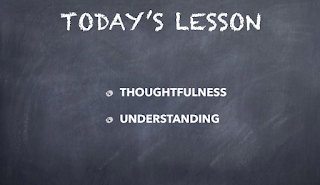Thoughtfulness is the state of thinking carefully about something. It is the quality of being kind, thinking about other people's needs, and showing concern, which is empathy. Children taught kindness and empathy are likely to grow into adults who consider how they might demonstrate more empathy and kindness in their regular interactions.
While many of a child's everyday activities, such as playing, going to school, etc., will provide natural opportunities to develop these critical traits, there is plenty we can do to proactively develop a child's thoughtfulness in the classroom.
Some of the tools that we may use are as follows-
Brainstorm ideas as a class
The brainstorming exercise develops thinking carefully about something and also develops ownership. We can have students brainstorm independently by passing out a notecard to each child and instructing the students to write down something nice that someone else did for them lately and how it made them feel. Once the students are done, collect the note cards and read them aloud to help the students understand acts of kindness.
Random acts of kindness
Once students understand what acts of kindness are, introduce them to random acts of kindness. Sharing this idea with students can encourage them to show kindness to their friends and families in unexpected ways. One method is to use complimentary notes or positive sticky notes. Provide the class with a supply of sticky notes and explain that anyone can take a sticky note at any time and write down a compliment for another student. They should sneak the sticky note onto that student's desk when he or she is not looking to make it genuinely random and fun.
Acts of kindness challenge
Give the students a goal to meet, such as performing three kind acts per week or noticing five kind acts per week. To keep them excited about the challenge, give them star stickers to add to a classroom chart or a paper cut-out to stick on a bulletin board when they meet their goal. As a teacher, we should make sure to practice some kindness ourselves. We can give each student at least one compliment before the end of the day. Before letting our students go for the day, tell them that you purposely complimented each of them during the day and that you noticed a positive change in the classroom mood. Explain that these positive changes are expected outcomes of practising kindness.
Understanding can be defined as sympathetic awareness. To understand the world around you, you need to develop empathy. You show empathy when you sympathise with someone and also display this. Empathy expresses itself in different dimensions – emotion, content, authenticity, timeliness, understanding the other person's feelings, what he is seeking, and reacting promptly.
Enhancing empathy in students is essential. The following tools will help:
Group Circle
The Group Circle activity encourages good listening skills and empathy. The children sit in a circle and pass a "talking piece" around. This is similar to passing the parcel. When the music stops, whoever has the "talking piece" has to speak for a minute on a given topic like, 'I really enjoyed ...', or 'I like my friend ____ because of ...' The exercise helps students relate to one another and can encourage them to accept and share feelings that may be difficult to talk about.
Nice things
Instruct each student to turn to his /her partner and share these positive "talking stems" or prompts:
One nice thing in my life is… Something nice that happened is…
Encourage the kids to be creative with their "nice thing". Assure them that the "nice thing" can be as small as eating something they liked for dinner last night. Next, ask volunteers who would like to share their "nice thing" with the class or who have given their neighbour permission to share their "nice thing". Sharing the "nice thing" will put the students in a more positive frame of mind and make them feel heard and affirmed by others.
Partner Up
This fun and easy activity will encourage your students to help one another. It's as simple as assigning each student a buddy or partner — you can allot or let the students pick their own buddy. Students will work with their partners and turn to their partners first when they need help. For example, if a student misses a day of class and needs copies of handouts, she should first ask her partner. Or, if a student is having trouble with a concept being taught, he should check in with his partner to see whether he or she can explain it before asking another person.
To make sure students get a chance to work on their relationship skills with a wide range of people and personalities, have them switch buddies regularly. They can find a new partner each week, every month, or any period that works for your class.
This activity will give your students ample opportunity to build communication skills, practice accountability, and be kind to one another.
Roopa Bhattacharyya
Ahlcon Public School

